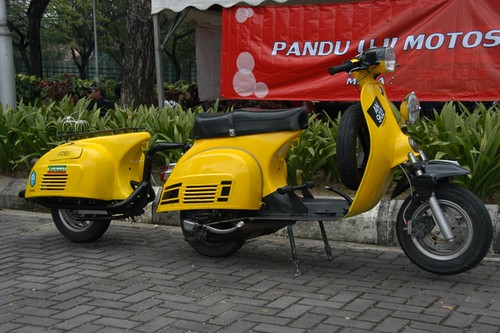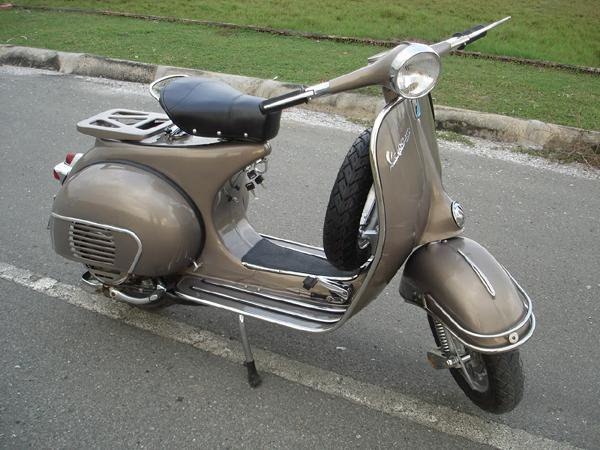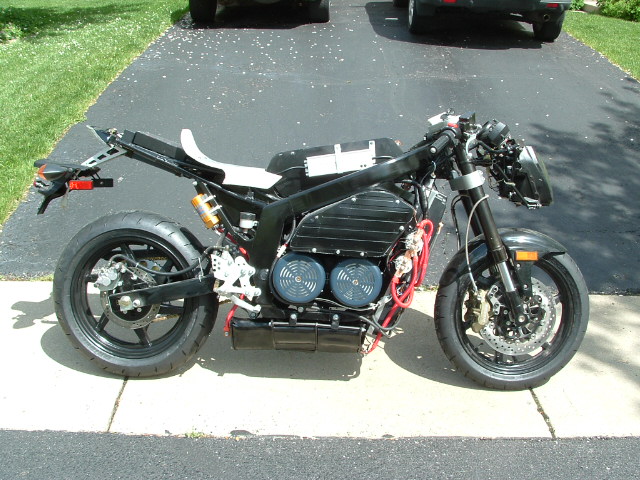
I like my scooters to be… well… scooterly. From a distance the Majesty looks massive, heavy and unwieldy. It’s only a smidgen smaller than the Suzuki Burgman 400. Sure, the Majesty may not be as big as a HD Nightster, which is 110 lbs heaver, but the Yamaha Majesty is still 110 lbs heavier than a smaller scooter like the Vespa GTV 250. So, what was I to do? Well it’s my job, so with a sigh I took her by the handlebars and went off to see what she was all about.
I just ignored my preconceptions. I thought to myself, “I’m just going to ride”, and I did. I rode for about an hour. Across backroads and highways, in and out of garages and parking lots, around u-turns and roundabouts and suddenly it hit me. HEY! Wait a sec! This is supposed to the “big, clumsy Majesty.” I had forgotten to remind myself of all my preconceptions. As it turns out the Majesty is a blast to ride! She was actually quite quick and nimble. Her turning radius was much tighter than I had expected and I was really pleased with how well the Japanese had thought out her ergonomics. Hold up… let me stop gushing for a second and get back to the Majesty’s statistics

Additional features Yamaha Majesty
A lot of energy and space for two, with integrated rail to take passengers.
huge storage, close under the seat will swallow up to 16 gallons of goods.
There’s even more storage for smaller items inside the front flap.
Cool super bright LED backlight and consumes less electricity.
Key Features Yamaha Majesty
This unit of high-tech transportation blurs the boundaries between the motorcycle and the motorcycle performance, very utilitarian.
Rugged and reliable four-stroke engine and fully automatic transmission mean hit the starter button and go.
There is more than enough power to run at highway speeds, space for two and plenty of storage space.

Chassis and Suspension Yamaha Majesty
Controlled Fill aluminum, cast iron main frame with steel tube frame is lightweight and rigid for increased performance and handling.
wheelbase of 61.6 inches provides enough room for tall riders and a smooth ride while improving handling.
41 mm fork tubes for excellent ride and sporty handling.
New design rear suspension uses a pair of long-distance, with spring shock absorbers for a smooth ride and sporty handling.
Great front, 14 inch and 13 inch rear tires on stylish cast wheels look great and provide excellent handling and traction with excellent bump.

Choose from first class. Choose the comfort and reliability. Choose the Yamaha Majesty 400. With a cast aluminum chassis and low center of mass help handling at all speeds, double-eye body offers fuel-saving aerodynamics and weather protection. While of Yamaha Majesty 4-stroke 395cc engine with fuel injection serves refined power, dual disc brakes at the front to provide powerful. An Yamaha Majesty ABS model is also available
Yamaha Majesty For longer trips, there is a double seat, instrumentation, automotive style, storage for two helmets and a hand glove. twin rear shocks means excellent driving comfort, while the stops are minimized with a fuel tank capacity of large size. All this at a special trip.

Engine Yamaha Majesty
Powerful liquid-cooled of Yamaha Majesty, DOHC four-valve single forged piston and single-axis counterbalancer out plenty of smooth power up beyond 8000 rpm.
Yamaha Majesty Electronic fuel injection with suction piston provides excellent throttle response and reliability with low maintenance.
Step-motor Yamaha Majesty controlled automatic control idle speed and throttle position sensor provide immediate start-up and walk away-performance.

 Piaggio was founded in 1884 in Italy by Rinaldo Piaggio. Initially, Piaggio is the manufacturer of the equipment that produces ships, trains and rail wagon train. At the time of the First World War berkecamuk, Piaggio produces aircraft.
Piaggio was founded in 1884 in Italy by Rinaldo Piaggio. Initially, Piaggio is the manufacturer of the equipment that produces ships, trains and rail wagon train. At the time of the First World War berkecamuk, Piaggio produces aircraft.

 Assisted by experts aircraft Corradino D'Ascanio, Enrico create a design of two-wheeled transportation with the inspiration and technology from the aircraft. Construction monoshock suspension to facilitate change tires adapted from the wheel of the aircraft, even the first product actually use the front wheel of the aircraft. Starter made from components of the bomb, and bodinya made of aluminum, such as body aircraft.
Assisted by experts aircraft Corradino D'Ascanio, Enrico create a design of two-wheeled transportation with the inspiration and technology from the aircraft. Construction monoshock suspension to facilitate change tires adapted from the wheel of the aircraft, even the first product actually use the front wheel of the aircraft. Starter made from components of the bomb, and bodinya made of aluminum, such as body aircraft.
















































